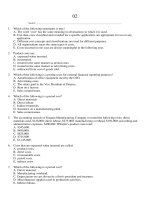Lecture Managerial accounting: Creating value in a dynamic business environment (10th edition): Chapter 17 - Ronald W. Hilton, David E. Platt
Bạn đang xem bản rút gọn của tài liệu. Xem và tải ngay bản đầy đủ của tài liệu tại đây (507.31 KB, 26 trang )
Chapter 17
Allocation of Support
Activity Costs and
Joint Costs
Copyright © 2014 McGraw-Hill Education. All rights reserved. No reproduction or distribution without the prior written consent of McGraw-Hill Education.
Service Department Cost Allocation
Service
Department
(Cafeteria)
Service
Department
(Accounting)
Service
Department
(Personnel)
First Stage Allocations
Service department costs are allocated
to production departments.
Production
Department
(Machining)
Production
Department
(Assembly)
The
Product
Second Stage Allocations
Production department overhead costs, plus allocated service department costs,
are applied to products using departmental predetermined overhead rates.
172
Selecting Allocation Bases
Personnel:
Number of
employees
Typical
Allocation
Bases
Receiving:
Units
handled
Security:
Square
footage
Custodial:
Square
footage
Cafeteria:
Number of
employees
Accounting:
Staff
hours
Power:
Kilowatt
hours
173
Selecting Allocation Bases
Personnel:
Number of
employees
Receiving:
Units
handled
Security:
Square
footage
Criteria for
selection
Simplicity
Availability
of space or
equipment
Benefits received
by the production
department
Accounting:
Staff
hours
Custodial:
Square
footage
Cafeteria:
Number of
employees
Power:
Kilowatt
hours
174
Interdepartmental Services
Service
Department
(Cafeteria)
Production
Department
(Machining)
POWER DEPARTMENT
Service
Department
(Custodial)
Production
Department
(Assembly)
175
Interdepartmental Services
Problem
Allocating costs when service departments
provide services to each other
Solutions
Direct Method
Step-Down Method
176
Direct Method
Cost of services
between service
departments are
ignored and all
costs are
allocated directly
to production
departments.
Service
Department
(Cafeteria)
Production
Department
(Machining)
Service
Department
(Custodial)
Production
Department
(Assembly)
For an example please see the textbook.
177
Step-Down Method
Service department
costs are allocated
to other service
departments and
to production
departments, usually
starting with the
service department
that serves the
largest number of
other service
departments.
Service
Department
(Cafeteria)
Production
Department
(Machining)
Service
Department
(Custodial)
Production
Department
(Assembly)
178
Step-Down Method
Once a service
department’s costs
are allocated,
other service
departments’ costs
are not allocated
back to it.
Service
Department
(Cafeteria)
Production
Department
(Machining)
Service
Department
(Custodial)
Production
Department
(Assembly)
179
Step-Down Method
Custodial will
have a new
total to allocate
to production
departments: its
own costs plus
those costs
allocated from
the cafeteria.
Service
Department
(Cafeteria)
Production
Department
(Machining)
Service
Department
(Custodial)
Production
Department
(Assembly)
For an example please see the textbook.
1710
Dual Cost Allocation
Charge to
production
departments at a
budgeted rate times
actual short-run usage of
the allocation base.
Allocate
budgeted amounts
to operating departments
in proportion to the
long-run average
usage of the
allocation base.
Budgeted costs should be allocated to avoid passing on inefficiencies
from the service departments.
1711
Dual Cost Allocation
Example
SimCo has a maintenance department and two production
departments: cutting and assembly. Variable maintenance
costs are budgeted at $0.60 per machine hour. Fixed
maintenance costs are budgeted at $200,000 per year.
Data relating to the current year are:
Production
Departments
Cutting
Assembly
Total
Long-run
Maintenance
Usage as a
% of Total
60%
40%
100%
Actual
Hours
Used
80,000
40,000
120,000
Allocate maintenance costs to the two operating departments.
1712
Dual Cost Allocation
Example
Cutting
Department
Variable cost allocation:
$0.60 × 80,000 hours used
$0.60 × 40,000 hours used
Fixed cost allocation
60% of $200,000
40% of $200,000
Total allocated cost
$
Assembly
Department
48,000
$
24,000
$
80,000
104,000
120,000
$
168,000
Variable costs are allocated based on hours used.
Fixed costs are allocated based long-run average usage.
1713
The New Manufacturing Environment
More
More accurate
accurate cost
cost tracing
tracing systems
systems
reduce
reduce the
the need
need for
for allocation
allocation
of
of indirect
indirect costs.
costs.
1714
The Rise of Activity-Based Costing
Service
Department
(Cafeteria)
Service
Department
(Accounting)
Service
Department
(Personnel)
First stage allocations are to
activities, not departments.
Activity
One
The
Product
Activity
Two
1715
Joint Product Cost Allocation
Joint
Product
Costs
Joint
Input
Oil
Joint
Production
Process
Final
Sale
Separate
Processing Costs
Gasoline
Split-Off
Point
Separate
Processing
Separate
Processing
Final
Sale
Separate
Processing Costs
1716
Allocating Joint Costs
Physical-Units
Method
Joint Product
Costs
RelativeSales-Value
Method
Net-RealizableValue Method
1717
Allocating Joint Costs
Physical-Units
Method
Allocation based on a
physical measure of the
joint products at the
split-off point.
Relative-SalesValue Method
Allocation based on
the relative values
of the products at
the split-off point.
Net-RealizableValue Method
Allocation based on
final sales values less
separable processing
costs.
1718
Physical-Units Method
Joint conversion
cost = $225,000
Joint material
cost = $275,000
Oil
240,000 gallons
Gasoline
360,000 gallons
Joint
Production
Process
Split-Off
Point
1719
Physical-Units Method
Product
Oil
Output quantities in gallons
Proportionate share:
240,000 ÷ 600,000
360,000 ÷ 600,000
Allocated joint costs:
$500,000 × 40%
$500,000 × 60%
240,000
Gasoline
360,000
Total
600,000
40%
60%
$ 200,000
$ 300,000
$225,000 joint conversion cost plus
$275,000 joint material cost
1720
Relative-Sales-Value Method
Joint conversion
cost = $225,000
Joint material
cost = $275,000
Oil
$200,000
sales value at
split-off point
Gasoline
$600,000
sales value at
split-off point
Joint
Production
Process
Split-Off
Point
1721
Relative-Sales-Value Method
Product
Oil
Sales value at split-off point
Proportionate share:
$200,000 ÷ $800,000
$600,000 ÷ $800,000
Allocated joint costs:
$500,000 × 25%
$500,000 × 75%
Gasoline
Total
$ 200,000 $ 600,000 $ 800,000
25%
75%
$ 125,000
$ 375,000
$225,000 joint conversion cost plus
$275,000 joint material cost
1722
Net-Realizable-Value Method
If products require further processing beyond
the splitoff point before they are marketable,
it may be necessary to estimate the net
realizable value (NRV) at the splitoff point.
Estimated
NRV
=
Final
Sales
Value
–
Added
Processing
Costs
1723
Net-Realizable-Value Method
Joint conversion
cost = $225,000
Joint material
cost = $275,000
Oil
Joint
Production
Process
Separate
Processing Costs
$200,000
Gasoline
Split-Off
Point, Sales
Value Unknown
Sales
Value
$500,000
Separate
Processing
Separate
Processing
Sales
Value
$1,200,000
Separate
Processing Costs
$500,000
1724
Net-Realizable-Value Method
Product
Oil
Sales value
Less additional processing costs
Estimated NRV at split-off point
Proportionate share:
$300,000 ÷ $1,000,000
$700,000 ÷ $1,000,000
Allocated joint costs:
$500,000 × 30%
$500,000 × 70%
Gasoline
Total
$ 500,000 $ 1,200,000 $ 1,700,000
200,000
500,000
700,000
$ 300,000 $ 700,000 $ 1,000,000
30%
70%
$ 150,000
$ 350,000
1725









